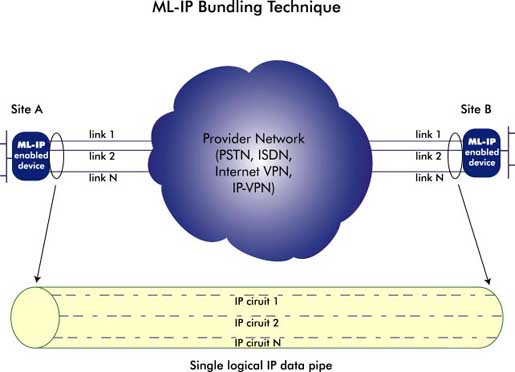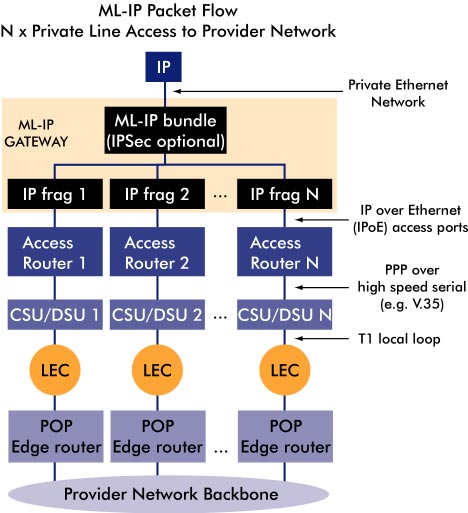
ML-IP uses a standard technique called bundling in a unique way that combines multiple IP circuits into a single logical data pipe. The IP circuits are created by ML-IP between IP connection peers at each site. When there are multiple IP connections at sites, ML-IP can automatically use multiple IP circuits in parallel. These may be permanent for “always on” connections or dynamic for “dialup analog/ISDN” connections. These IP circuits may be spread across IP connections from multiple providers.
To spread data across the multiple IP circuits, ML-IP splits the payload of each outgoing IP packet into smaller fragments, encapsulating these fragments into new IP packets. These new IP packets are transparently routed by ML-IP through the IP connection associated with the IP circuit.
ML-IP gains its independence from intervening networks by maintaining IP addressing. New IP packets can travel independently of each other along parallel IP circuits to the remote IP connection(s). ML-IP monitors the condition of the IP circuits automatically, which enables bandwidth to throttle up or down transparently, with corresponding links brought online or dropped accordingly.

ML-IP splits packets consistently and transfers them across multiple IP circuits, so performance gains are predictable, unlike other less granular bandwidth aggregation schemes. ML-IP eliminates many problems that exist in other Multilink connection aggregation schemes. These typically require Multilink-capable equipment and configuration within the provider network access points and some techniques are not extensible to IP networks.
At the destination site, ML-IP retrieves multiple payload fragments and reassembles them into the original IP packet, which is then forwarded to the internal IP destination. ML-IP can optionally invoke the full range of IPSec transforms at each site. This enables strong authentication and encryption of the data (e.g. across a public network such as the Internet). In addition, ML-IP supports additional encapsulation of IPSec packets to enable them to traverse restrictive firewalls that normally block IPSec traffic.
The following diagram shows an expanded view of the packet flow through an ML-IP enabled device at Site A, using multiple private circuits to a provider network. This flow is repeated (in reverse order) at the destination Site B and is transparent to the POP edge routers.

![]()
about ePipe | products | solutions | support | information center | contact us
Copyright © 2002 ePipe Pty. Ltd. All rights reserved.